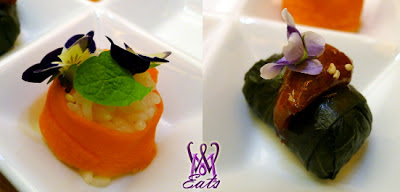For years, the only high-end restaurants in Seoul were European, or sometimes Japanese. Korean food was everyday food, not special occasion food, but in the last several years, a group of imaginative young chefs has taken Korean food in the South Korean capital in unexpected directions, pairing 21st-century cooking techniques with traditional flavors. The result? A whole new kind of cuisine, served in international-standard restaurants, based on Korean ingredients and created by Korean chefs.
We had the fortunate experience to have dinner at Si Wha Dam on our first night in Seoul. On the entrance floor, there are display cases filled with ancient relics and antiques, including traditional burial accessories from the second and third centuries -- clay ducks and roosters, spiritual intermediaries between heaven and earth. We were seated in a private room with a prime view of a lovely girl in traditional wear playing the Korean mandolin. There are different prix fixe menus and rooms that can be reserved according to price. We arranged to have the course "A Healthy Story", which was 55,000 KRW per person. The service was top notch with the staff telling the "story" of each dish as it arrived. It must be noted that buzzers are on each table, that tie back to a watch that your server wears. In case you need anything at all, simply press the buzzer and she is there in a second!
First, we began with Bean Paste Porridge with Little Neck Clams and Chives. This is a common amuse buche in traditional Korean meals. Then we shared a Wild Greens Salad with Smoked Duck and Fermented Peach. The peach pieces were dried and slightly tart.
 To accompany the meal, we tried a sweet black raspberry wine called bokbunjajoo. It was served cold with small cups like sake or sochu but had a more rich berry wine flavor. It was a bit too syrupy for me, so I only had a couple sips. The next colorful dish we received was a Seafood Pancake with Spring Greens. Sprinkled with edible flowers, this dish truly looked like a watercolor painting. This was an elegant presentation of another more common appetizer dish. Next, what appeared to be sushi was not at all - a carrot flower wrap and a sesame seed leaf wrap with pickled plums were lovely vegetable and rice bites with pops of flavor.
To accompany the meal, we tried a sweet black raspberry wine called bokbunjajoo. It was served cold with small cups like sake or sochu but had a more rich berry wine flavor. It was a bit too syrupy for me, so I only had a couple sips. The next colorful dish we received was a Seafood Pancake with Spring Greens. Sprinkled with edible flowers, this dish truly looked like a watercolor painting. This was an elegant presentation of another more common appetizer dish. Next, what appeared to be sushi was not at all - a carrot flower wrap and a sesame seed leaf wrap with pickled plums were lovely vegetable and rice bites with pops of flavor. These artistic sensibilities take center stage on plates of food that seem too gorgeous to be consumed. Another dish called the Korean Lunch Box is a fun pay on a sandwich made with jeongpyun (Korean yeast rice cake) used as the bread filled with bulgogi meat and vegetables with a special pine nut sauce. While I did not eat this dish because of the meat, Keith enjoyed it and it was artistically presented on a plate with traditional calligraphy paper and writing utensils, to further tell the story of Korean history.
When Kimchi Met Pasta is a perplexing mix of flavors with squid ink spaghetti sauteed with kimchi and a seafood sauce. Although I usually cannot handle the spice factor of kimchi, this dish was addictive and the rich seafood sauce had French influence that mellowed out the spicy pickled cabbage. The beautifully arranged dish, inspired by Henri Matisse's style entitled, Plate of Blowing Wind From Salt Ponds and the Flower of Salt, is one of those "too pretty to eat" dishes. Spoons of frozen vegetables and fruit mixed with prawns and pine nut mustard sauce are displayed with famous Korean salt and gave a palate cleansing effect.
The next dish, titled Fields of Wheat Ripening in the Sunshine, is arranged to evoke exactly that, with a fan of greens mimicking a spray of wheat on mushroom and garlic "earth" under the kimchi sun. The main portion of the courses arrive on a traditional basket, similar to the type that women used to carry meals out to the men who worked in the fields. Thus, the name Old Day's Wild Field Meal, this course is the traditional spread of banchan with rice. With it, we are served a rice milk drink that is a bit sour but is supposed to help with digestion. To end the meal, we are served Hwajeon, a rice pancake with honey, and Organic Omija Punch, a punch made from fruit.
Indeed, the meal is a parade of handcrafted plates, each decorated with flowers that had been picked that day. The "Healthy Story" shined through each course of organic ingredients and the modern interpretation of traditional Korean cuisine was innovative and delightful. We had an incredible and memorable first meal in Korea.
Total Rating: 4.75
Food: 5, price: 4, Service: 5, Ambience: 5, Accessibility: 4

What I ate:
Bean Paste Porridge with Little Neck Clams and Chives
Wild Greens Salad with Smoked Duck and Fermented Peach
Seafood Pancake with Spring Greens
Carrot Flower Wrap and Sesame Seed Leaf Wrap with Pickled Plums
♥When Kimchi Met Pasta♥
squid ink spaghetti sauteed with kimchi and a seafood sauce
♥Plate of Blowing Wind From Salt Ponds and the Flower of Salt♥
frozen vegetables and fruit mixed with prawns and pine nut mustard sauce
Fields of Wheat Ripening in the Sunshine
chives with mushrooms and kimchi
The Old Day's Wild Field Meal
Hwajeon and Organic Omija Punch
rice pancake with honey and a fruit punch
Plus others ate:
Korean Lunch Box
sandwich made with jeongpyun (Korean yeast rice cake)
with bulgogi meat and vegetables with a special pine nut sauce














